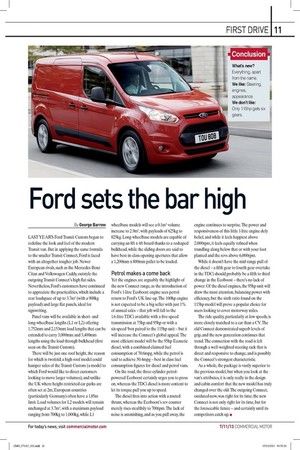Ford sets the bar high
Page 7

If you've noticed an error in this article please click here to report it so we can fix it.
By George Barrow
LAST YEARS Ford Transit Custom began to redefine the look and feel of the modern Transit van. But in applying the same formula to the smaller Transit Connect, Ford is faced with an altogether tougher job. Newer European rivals, such as the Mercedes-Benz Citan and Volkswagen Caddy, outstyle the outgoing Transit Connect's high flat sides. Nevertheless, Ford's customers have continued to appreciate the practicalities, which include a rear loadspace of up to 3.7m3 (with a 908kg payload) and large flat panels, ideal for signwriting.
Panel vans will be available in shortand long-wheelbase lengths (L1 or L2) offering 1,752mm and 2,153mm load lengths that can be extended to carry 3,000mm and 3,400mm lengths using the load through bulkhead (first seen on the Transit Custom). There will be just one roof height, the reason for which is twofold; a high-roof model could hamper sales of the Transit Custom (a model to which Ford would like to direct customers looking to move larger volumes); and unlike the UK where height-restricted car parks are often set at 2m, European countries (particularly Germany) often have a 1.85m limit. Load volumes for L2 models will remain unchanged at 3.7m3, with a maximum payload ranging from 700kg to 1,000kg, while L1
wheelbase models will see a 0.1m3 volume increase to 2.9m3, with payloads of 625kg to 825kg. Long-wheelbase models are capable of carrying an 8ft x 4ft board thanks to a reshaped bulkhead, while the sliding doors are said to have best-in-class opening apertures that allow a 1,200mm x 800mm pallet to be loaded. Petrol makes a come back
Yet the engines are arguably the highlight of the new Connect range, as the introduction of Ford's 1-litre Ecoboost engine sees petrol return to Ford's UK line-up. The 100hp engine is not expected to be a big seller with just 1% of annual sales — that job will fall to the 1.6-litre TDCi available with a five-speed transmission at 75hp and 95hp or with a six-speed 'box paired to the 115hp unit — but it will increase the Connect's global appeal. The most efficient model will be the 95hp Econetic diesel, with a combined claimed fuel consumption of 70.6mpg, while the petrol is said to achieve 50.4mpg — best in class fuel consumption figures for diesel and petrol vans.
On the road, the three-cylinder petrolpowered Ecoboost certainly urges you to press on, whereas the TDCi diesel is more content to let its torque pull you up to speed. The diesel fires into action with a muted thrum, whereas the Ecoboost's rev counter merely rises stealthily to 700rpm. The lack of noise is astonishing, and as you pull away, the
engine continues to surprise. The power and responsiveness of this little 1-litre engine defy belief, and while it feels happiest above 2,000rpm, it feels equally refined when trundling along below that or with your foot planted and the revs above 6,000rpm.
While it doesn't have the mid-range pull of the diesel — a fifth gear to fourth gear overtake in the TDCi should probably be a fifth to third change in the Ecoboost — there's no lack of power. Of the diesel engines, the 95hp unit will draw the most attention, balancing power with efficiency, but the sixth ratio found on the 115hp model will prove a popular choice for users looking to cover motorway miles.
The ride quality, particularly at low speeds, is more closely matched to a car than a CV. The old Connect demonstrated superb levels of grip, and the new generation continues that trend. The connection with the road is felt through a well-weighted steering rack that is direct and responsive to change, and is possibly the Connect's strongest characteristic. As a whole, the package is vastly superior to the previous model, but when you look at the van's attributes, it is only really in the design and cabin comfort that the new model has truly changed over the old. The outgoing Connect, outdated now, was right for its time; the new Connect is not only right for its time, but for the foreseeable future — and certainly until its competitors catch up. •








































